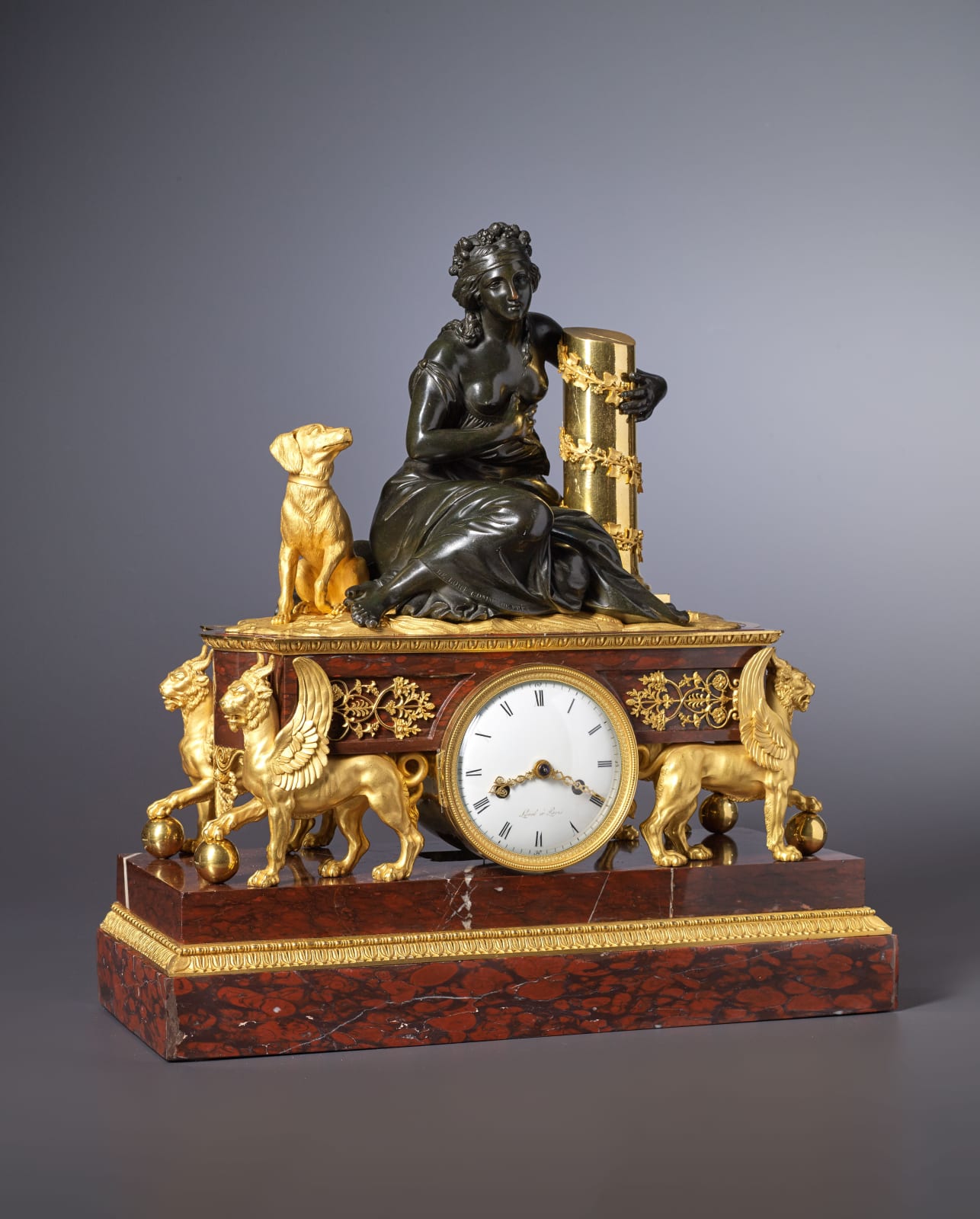Levol
A rare and extremely fine Empire gilt and patinated bronze and rouge griotte marble mantel clock of eight day duration signed on the white enamel dial Levol à Paris and housed in a magnificent case attributed to either Pierre-Philippe Thomire or André-Antoine Ravrio. The dial with Roman numerals and a fine pair of gilt brass hands for the hours and minutes. The movement with anchor escapement, silk thread suspension, striking on the hour and half hour, with outside count wheel.
The case surmounted by the patinated figure of Erigone who sits wearing a classical dress that falls below her breasts and is inscribed around its hem: DE LOIN COMME DE PRÈS, wearing a head band in her hair she looks downward while clutching a tilted pillar entwined with grapes and vine leaves, to the right of her sits her father’s dog Maera, the figure and dog on a cloth that is lain over a shaped rectangular marble plinth with bow ends, encompassing the upper part of the clock dial and decorated on the frieze with pierced foliate mounts encircling a thyrsus, the plinth supported on the back of gilt outward facing griffons who stand with one foot resting on a sphere, the griffons and base of the clock dial supported on a stepped rectangular marble base with beaded and stiff leaf banding
Paris, date 1810
Height 47 cm, width 44 cm, depth 19 cm.
This extremely rare and probably unique clock case features Erigone who was the daughter of Icarius - an Athenian and the subject of a poem by the 3rd century BC astronomer and poet Eratosthenes. The story was also recounted in Ovid’s Metamorphoses which tells how Bacchus, the mythological god of wine, fell in love with Erigone and visited her disguised as a bunch of grapes, hence the presence of vine leaves on the pillar as well as the thyrsus on the frieze. Bacchus also taught Icarius how to cultivate the vine and to make wine. Icarius then offered the newly made wine to neighbouring shepherds, who on feeling its effect believed that they had been poisoned and while intoxicated they killed Icarius. Stricken with grief and unable to find her father, Erigone sought aid from her father’s dog, Maera who led her to his body and having buried him Erigone then hung herself from a tree above his grave. The tree is symbolised by the vine entwined pillar while the words: de loin comme de près, meaning: from near to far, as inscribed around her dress, are reference to one of the original texts. According to certain narratives Maera also killed himself by jumping into a well and in turn the Athenian virgins took their own lives until Erigone’s ghost was appeased. After consulting the Delphic oracle, the Athenians punished the shepherds and honoured Erigone by initiating a feast at which small disks decorated with heads (known as oscilla) were suspended from trees.
It was also said that Erigone was transformed into the constellation Virgo, her father into Boötes and Maera the dog into Canicula (Procyon) Erigone was the subject of a number of other clock cases. One of the best known was made by the esteemed fondeur-ciseleur Pierre-Philippe Thomire (1751-1843). It shows her lying in abandon surmounting a clock housing a movement by Laguesse à Paris which was acquired by Tsar Paul I in 1799 for his newly built palace of St Michel, St. Petersburg and is now at Pavlovsk Palace. Another, slightly later clock with case again by Thomire, in the Musée du Louvre, Paris features Erigone (sometime referred to as a Bacchante) eating grapes while lying on a dormeuse. Interestingly an almost identical case was made by Thomire’s contemporary André-Antoine Ravrio (1759-1814). Significantly the sides of the dormeuse is of the same arrangement as the present plinth which likewise is rectangular and encompasses the top of the dial bezel within the intricately mounted frieze but is supported on satyr headed goat feet rather than griffons.
Although little is known of the Parisian clockmaker Levol (fl. 1806-post 1839), whose name appears of the clock’s dial, Tardy notes that he was based at rue du Temple in 1806 and rue de la Corderie between 1817 and 1820. In addition, the Paris almanac of 1839 notes him to be at 79 rue du Temple. Levol’s name appears on a number of important early nineteenth century figural clocks including one with a case attributed to Pierre-Philippe Thomire representing Paul et Virginie of circa 1810-20, which according to family repute was once housed at the Palais des Tuileries (sold in Paris 1st June 2012). Levol also provided the movement for a pendule d’Amerique with case by Jean-Simon Deverberie as well as another clock with bas relief (possibly portraying the imperial council) supported on lion paw feet, which is signed on the dial Levol à Paris and on the movement Farret à Paris and is owned by the maison de l’infirmier de l’abbaye Saint-Oyend in the Jura Franche-Comté.
